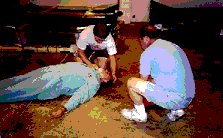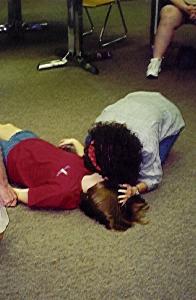| CPR,
AED, First Aid, OSHA Training, OSHA Consulting Nationwide. Online
CPR, AED, First Aid Training. |
Training
AED
Programs
Links
AED
Instructor Forum
American
Cancer Society
American
Heart Assn.
ASHI
Becker
Training Associates, LLC
Business.com
Corporate
Health & Safety Classes
Corporate
Training
ECSI
eACLS.com
Emergency
Response Techniques, Inc.
ESCAPE
Fire & Safety Services
Life
Happens
Lifeline
Videos
MA
Institute of Fire Service Instructors
MSDSSearch.com
National
Center for Early Defibrillation
Occupational
Safety Systems
OSHA-Directory
Regiononline.com
Rescuebreather.com
RescueHouse.com
River
Valley Juvenile Firesetter Intervention Program
Webs
Biggest: Safety
|
|
|
AED
Home Page
Automated
External Defibrillator
Welcome
The GETS AED Pages are full of information
and equipment that will help you create a successful AED Program. Contact
us anytime with your questions and to start your AED Program. GETS provides
complete AED Program support to all of our existing or new clients.

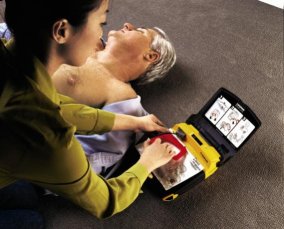

|
Medtronic
Lifepak CRPlus AED
Medtronic created the LIFEPAK CR Plus defibrillator
specifically for the first person at the scene of a sudden cardiac arrest.
Designed for the minimally trained and infrequent rescuer, it’s easy to
understand and use in a cardiac emergency, when every second counts. It’s
just plain simple.
Semi or Fully
Automatic Shock Delivery
The
CR Plus is available in a semiautomatic and fully automatic model. Withthesemi-automatic
CR Plus you assess the person in
sudden cardiac arrest, then open the device and apply the electrodes. The
device analyzes the heart’s rhythm and tells you to push a button if the
heart needs a shock.
The fully
automatic CR Plus requires just the
first two steps, and the device does the rest.
Fast & Simple
Sleek, lightweight
design for grab-and-go portability.
Clear screen messages, voice prompts, readiness display
and lighted buttons guide responders.
Intuitive design ideal for infrequent or inexperienced
users.
Pre-connected electrodes save valuable time on-scene.
Electrode pad diagrams illustrate optimum placement.
|
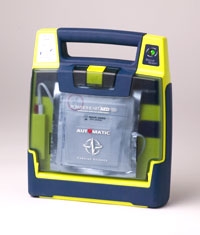
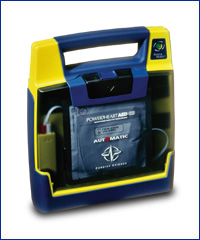
|
Cardiac Science
Powerheart G3 Plus AED
Featuring more than 80 patents, the Powerheart G3
Plus AED offers a unique combination of features that no other AED can
match in providing an easy to use, reliable and technologically advanced
lifesaving device.
New, Rescue Coach™ intuitive voice prompts were designed
using the results of a human behavior study to guide the rescuer confidently
and easily through the rescue process and provide instructions and AED
behavior aligned with the AHA/ERC 2005 Guidelines. The new detailed instructions
for CPR include a metronome to assist with frequency of compressions.
Patented Rescue Ready® daily, weekly and monthly
self-tests ensure that critical components such as pads, battery and internal
circuitry are always in working order and validate reliability. Another
unique feature for Powerheart AEDs is the monthly full-energy self test
which confirms that the AED can charge to its maximum capability.
Patented non-polarized defibrillation pads simplify
the placement process as either pad can be placed in the upper right chest
or lower left chest area. Powerheart AEDs also feature a text screen which
displays text prompts for use in a loud rescue environment, or by rescuers
who are hearing impaired.
Ease-of-use
-
Available with fully-automatic or semi-automatic operation.
-
Rescue Coach intuitive and comprehensive voice prompts guide
users through the rescue.
-
Metronome for proper CPR compression frequency.
Reliability
Patented Rescue Ready® technology includes daily, weekly,
and monthly self-tests of battery, internal electronics, software, and
pads, which assures first time, every time shock delivery.
Additional G3 Plus Features
-
Outstanding voice prompt quality and clarity.
-
4 - Year full operational replacement battery guarantee.
|
What is an AED?
An AED is a medical device designed
to "shock" the heart of a victim in cardiac arrest (no pulse or breathing)
back into a survivable electrical/mechanical rhythm. This is a time sensitive
treatment. For every minute a victim is in cardiac arrest, they lose
10% chance of survival, and shocking the heart with an AED is the best
treatment for this life-threatening condition.
What is Sudden Cardiac Arrest?
Each year, 350,000 people die in the United States
alone of sudden cardiac arrest. The problem is an electrical disturbance
in the heart that causes it to "quiver" instead of beating normally. It's
called ventricular fibrillation (V-Fib). These are people who "just
dropped dead." The treatment - RAPID Defibrillation ("shock") LESS
than five minutes from "DROP" (victim in cardiac arrest) to "SHOCK"
(AED on and able to defibrillate). Sudden Cardiac Arrest is an indiscriminate
killer. It kills no matter the age, race or sex of its victim- including
children!
What is a Public Access AED Program?
A Public Access AED Program (PAD) allows
the AED and other lifesaving equipment to be accessible to ANYONE who is
trained in its use, or any Good Samaritan who chooses to use the equipment
to save a life. This cuts down the time from "DROP" to "SHOCK" and gives
the victim a greater chance of survival. Public Access programs are STRONGLY
recommended anywhere the general public gathers, and in the workplace.
These programs are recommended by the American Heart Association, American
Safety and Health Institute, National Center for Early Defibrillation,
Occupational Safety and Health Administration (OSHA) and many other national
organizations.
GETS Goal
The goal of GETS and our Lifesaving Road Tour is
to improve the survivability of sudden cardiac arrest victims by placing
defibrillators in:
-
Government Facilities
-
Transportation Facilities (Airports /
Aircraft, Train Stations / Trains, Bus Lines & Depots, etc.)
-
Businesses & Industry
-
Shopping Malls and Large Shopping Centers
-
Places of Worship
-
Tourist Attractions & Facilities
-
Stadiums
-
Recreational Facilities (Golf, Country
Clubs, Pools, Boating, etc.)
-
Healthcare Facilities
-
Education Facilities
-
Hotels and Resorts
-
Amusement Parks and Attractions
-
Anywhere a Lifeguard is present
-
Community AED Programs
-
Rural Areas
How Do I Create and Manage a Successful Program?
Please view the AED pages listed LEFT and contact
GETS to assist you in all aspects of your AED Program. |
AED Program Components
AED Programs provided by GETS
are designed specifically for your facility. This page is dedicated to
providing you step-by-step instructions for implementation of an AED Program.
GETS
will assist you in all areas of AED purchase, deployment and management.
From Casinos to Community
Centers, AED & Life Safety Products allow you to react seamlessly to
an emergency anywhere you work or play!
AEDs are easy to use and maintain. In just a few
short hours of training, responders will learn the skills necessary to
save a life. Follow-up training and drills provided by GETS Training Centers
will help hone your responders skills and make them prepared for WHEN an
emergency does occur. GETS is here to help you step-by-step to develop
and implement your AED Program and Emergency Response Team!
Our personnel and affiliates are dedicated healthcare professionals (EMTs,
Paramedics, Nurses, Physicians) that use this equipment in real life. We
want to share our experience with you to make you feel confident in an
emergency situation.
AED Program
Implementation Guide
Thank you for considering an AED Program. By placing
AEDs in key locations where people work, live and play, you can give a
victim of sudden cardiac arrest another chance at life! Make a copy of
this page and use it as a checklist for starting your program. Call GETS
for assistance and guidance in setting up and running your program.
 |
Public Access
AEDs are designed to provide treatment to a life-threatening
electrical disturbance in the heart QUICKLY! This device
is meant to be in public access, not only for your responders, but also
for trained bystanders who may be present as staff or visitors.
Not Just an AED Hanging on a Wall!
AEDs are lifesaving medical equipment.
They REQUIRE little effort to maintain their readiness, HOWEVER, it is
important that your responders, staff and other bystanders know the importance
of this equipment, check it regularly and practice often. Both our responder
bags and cabinets have easy view windows to see unit status. |
( ) Decision Makers
Identify decision makers and arrange a meeting to build support. Contact
GETS when you need help demonstrating equipment, showing the importance
of an AED program, or urging people to contribute to your program.
( ) Review Your Laws & Regulations
Good Samaritan Laws now exist in all states to protect the layperson
responder who choose to help victims in distress. The Cardiac Arrest Survival
Act of 2000 encourages placement of AEDs in all federal buildings and ensures
federal liability protection for those who acquire or use an AED to help
save a life. TRAINING IS REQUIRED!Contact
GETS for full details and assistance with laws in your state.
( ) Identify Your Response Team
Now it is time to decide who your response team members are. Who is
likely to respond in an emergency at your facility?
People already expected to provide CPR and first aid in an emergency
(security, floor wardens, lifeguards, managers, coaches, existing emergency
response teams)
People trained in an AED program (flight attendants, teachers, church
ushers & ministers)
Volunteer firefighters and EMS workers
Volunteers who want to be part of your response team
( ) Medical Direction
Although AEDs are designed for use by laypeople with minimal training,
they are classified as a Class III medical devices by the US Food and Drug
Administration (FDA), and cannot be purchased without a prescription from
a physician. Medical oversight of your program is required. The physician
is not required to be present when the AED is used, but must be aware of
how you were trained (and follow-up training), and any uses of the AED.
Medical direction may be provided by:
GETS, Inc, has physicians and programs available to streamline the process
(cost may apply)
A physician employed or contracted for your facility
Local EMS Medical Director
An interested physician in your community or local hospital
GETS will assist in the process of getting your Medical Director
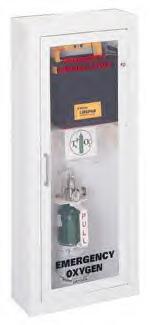 |
( ) Assess how many AEDs you will need & where
to place them
The American Heart Association and all major curriculums recommend
defibrillation in less than 4 to 5 minutes. Every additional minute delay
to defibrillation decreases the victim's chances by 7% to 10%. To have
a successful program, you will want enough AEDs in the right place, a clear
way of communicating dispatch of your team, and enough people trained to
respond quickly to the closest AED unit.
AED Cabinets (shown w/ optional Emergency Oxygen) will enhance
your quick response and allow anyone trained in the use of an AED access
to this lifesaving equipment.
Applying the AED and delivering the first shock takes approximately
1 minute. To meet the 3 minute "from drop to shock" rule leaves you 2 minutes.
GETS
will analyze your facility's layout, and provide you with recommendations
on AED equipment placement. |
( ) Budget Your AED Program
Consider cost of equipment, training and promotion of your program:
Initial expense of AED and related equipment (purchase vs. leasing)
Initial training and refresher training
Replacement of batteries and electrodes (defib pads).
Public Access Cabinet
Responder needs: bloodborne pathogens protection, "uniform" to identify
responders (hat, shirt, jacket, vest), communication equipment
Now Purchase your AED Products - Training - Services
from GETS
888-205-8988
(toll free)
( ) Design Response Policies and Procedures
If you already have an Emergency Action Plan, integrate the AED equipment
into the existing plan. Standard operating policies and procedures (SOP)
should be placed in service and reviewed and updated frequently.
Who manages the AED program?
Who provides medical direction?
Standing orders for the use and training required for the AED Program
How internal and community responders are notified of an emergency
Types and location of AEDs and emergency equipment
Training and review training policy
Routine schedule for checking of equipment (checklists provided by GETS,
Inc)
Regular review of SOP's
All records required when the AED is used
GETS will help you develop this plan, write it, and provide oversight
of all aspects of your program.
( ) Train the Responders & Place the Equipment
In Service!
GETS - ECSI will train your responders and help you place the
equipment in service. We will check to make sure all equipment
is available and functioning after training is complete. Continued use
of our instructors through our Training Partner Program brings you
the added benefits of being trained and coached by the same team each time
training is required and FREE REPLACEMENT of your AED Electrodes with any
use or every two years when we return to do refresher training.
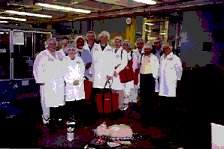 |
Emergency response is a group effort, and the teams we have helped
form from coast-to-coast feel confident with their skills after GETS training
and support. Being able to respond to a crisis requires preplanning and
preparedness. We are here to help you through the entire process!
The AED is only a PART of the response equipment. Typically, the responder
is faced with a "live" victim, but an emergency situation may call for
CPR, AED, first aid, the use of emergency oxygen and responder protection
from bloodborne pathogens. |
That is why our training is comprehensive and includes:
AED
CPR
Emergency Oxygen
First Aid
Bloodborne Pathogens
GETS has AED Responder Program Training Packages
that includes the modules above. You can choose the program and equipment
that is right for your facility.
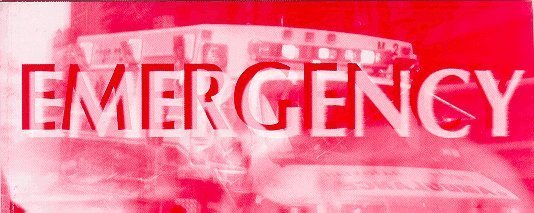 |
( ) Notify Your Local EMS
Notifying your local EMS that you have started an AED program is good
practice, and it is required in most states. GETS will introduce
your local EMS to your program and invite them to participate in "drills". |
TEAM EFFORT!
Facility Management - AED Program Manager - Responders
- GETS..
Because When You Save a Life
... Everybody Wins!
AED Program
Oversight
Congratulations! You have chosen to acquire our
program, and have contacted GETS to assist you with your AED Program.
You will find below how we perform as your partner in managing your AED
Program. Most of these services are provided at no additional cost
to you!
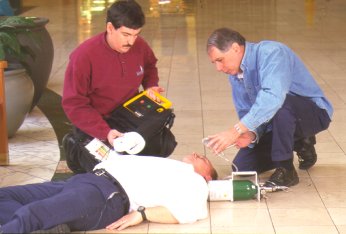

|
AED Program Initiation
Congratulations! You have chosen to start your program.
GETS will provide:
Meet with person(s) responsible for the AED program.
Walkthrough of your facility and identify location(s)
for your equipment.
Create communication method for responders to be
notified of an emergency and proper emergency procedures.
Create a method to identify responders.
Write your AED Response Procedures.
Assist in placing your AEDs and other equipment in
service.
Train your responders and introduce them to your
facility.
Familiarize others not on your response team to the
program.
Assist in publicizing your program.
Coordinate program start-up with your AED Program
Medical Director.
|
 |
AED Program Maintenance
Your program is up and running, and your equipment
needs to be treated as the life saving equipment that it is. We assist
by:
Instructing your personnel how to perform regular
inspections of your equipment.
Provide checklists to make inspections simple.
Database information for equipment (AED and O2),
disposables (pads and battery) advise when they need to be replaced, store
downloaded logs of all actual uses. Quarterly Report
Provided / Available Anytime Via E-Mail.
OPTIONAL: On-site inspections by our trained staff
and affiliates.
Database training provided and refresher dates. Quarterly
Report Provided / Available Anytime Via E-Mail.
Provide on-going training and "Skills Drills"™
Track national clinical and procedural information.
Update personnel on any changes in policies and/or
procedures.
|
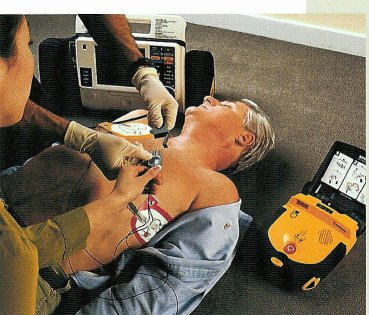
|
AED Program - After an Event
Critical events involving AEDs require information
gathering and notifications to various agencies. We provide:
Use Survey Forms to document any emergency response.
Sending the form to GETS will trigger a call from us for details.
Debriefing (phone or in person) of the responder(s)
Information download from the AED.
Copies of downloaded information to EMS and receiving
hospital.
Medical Director notification and copy of downloaded
AED information.
Report on status of victim (if available).
AED Survivors united with the National Center
for Early Defibrillation - Survivor Network.
Assist in publicizing any AED save with media.
|
|
